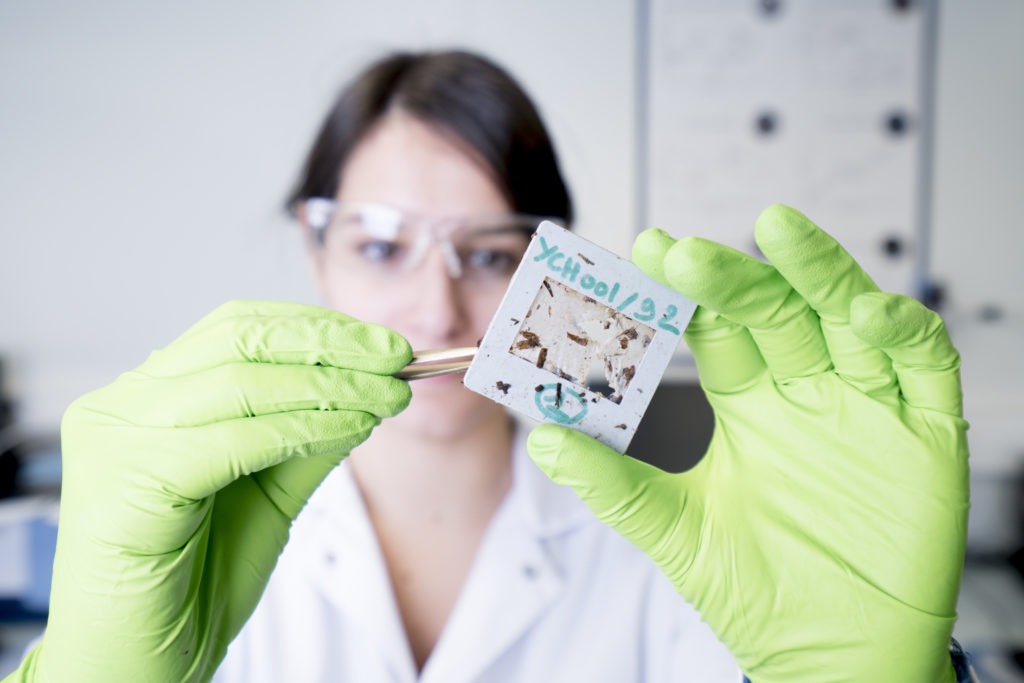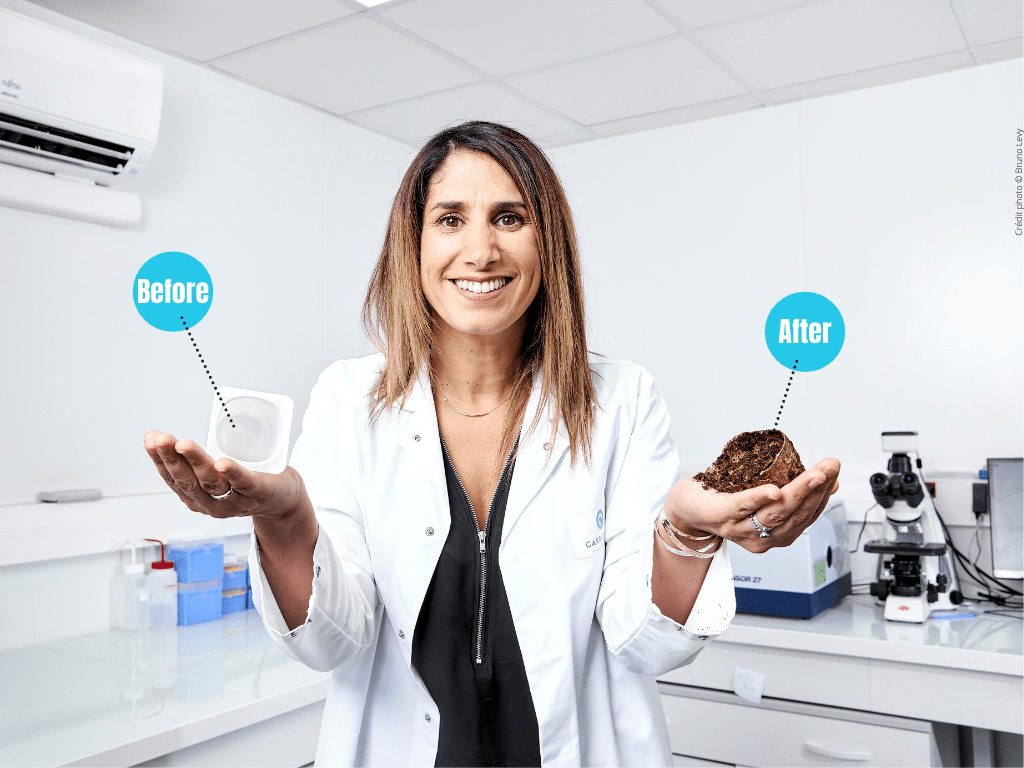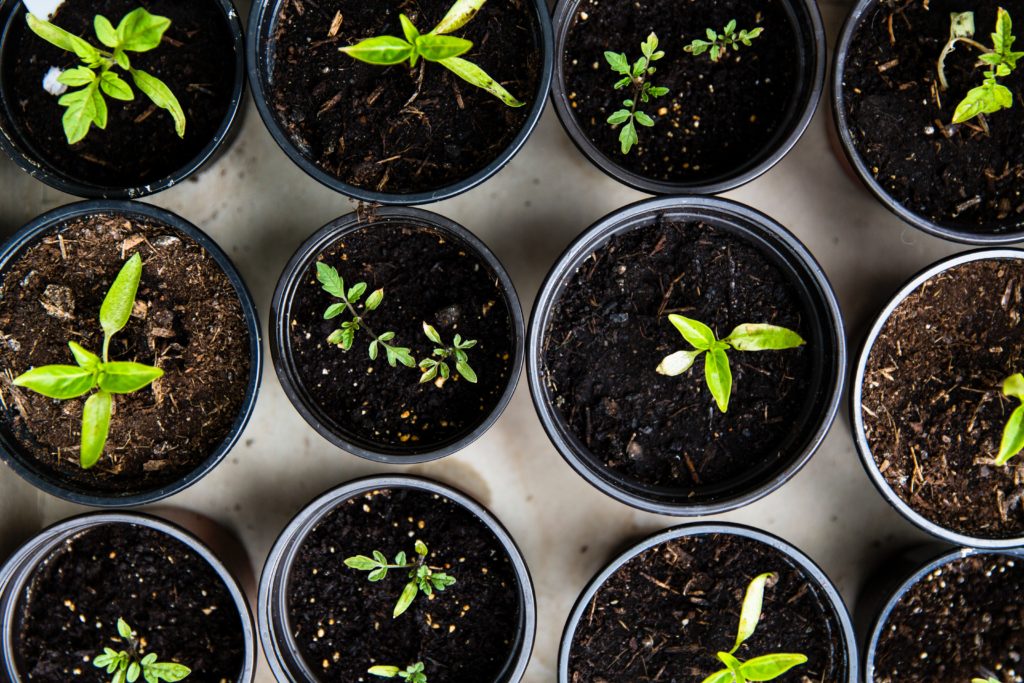What are biodegradable plastics?
For more than 20 years, biodegradable plastics have been used in consumer goods such as bags, packaging, and everyday products, representing a total of nearly 1 million tonnes per year worldwide. However, the concept of end-of-life biodegradation for these products is often confused or misused. What does this word actually mean? Here’s everything you need to know!
Plastics and plastic packaging are everywhere around us, with a disastrous impact on the planet. France alone generates nearly 3.5 million tonnes of plastic waste per year and packaging is responsible for nearly 60% of all plastic waste in all sectors. (Atlas du plastique 2020).
In response, there has been growing interest in recent years for developing new types of biodegradable plastics.
In 1974, certain polymers were shown to degrade quickly in soils with many microorganisms. In the past 20 years, researchers have been looking into more eco-friendly plastic solutions.
But how does plastic packaging biodegrade? How does it differ from compostable plastic? Are all bioplastics biodegradable? Let’s look more closely at the concept of biodegradability.
What is biodegradation?
“A product is biodegradable when it can be decomposed by biological organisms (bacteria, fungi, algae, etc.) in a favourable environment (temperature, humidity, light, oxygen, etc.)”— Futura Science. Biodegradation can be “anaerobic” (without oxygen) or “aerobic” (in the presence of oxygen).
More specifically, biodegradation has two key steps:
- Fragmentation: in this first phase, the product deteriorates in a process called disintegration. It is generally caused by external agents such as microorganisms or other living beings (earthworms, insects, etc.) that break down the product. This first phase is very useful because it breaks the material into fragments that are more accessible to microorganisms.
- Assimilation: in this second phase, actual biodegradation occurs. Microorganisms attack the material, producing water, carbon dioxide, methane, and biomass that do not harm the environment.
Two main factors affecting biodegradation
1—The biodegradation medium: some materials biodegrade more easily via composting than directly in the soil. The medium’s physicochemical properties are critical, not only for the effectiveness of the microorganisms involved in biodegradation but also for the material to be degraded. There are three important factors: temperature, which encourages microbial activity; the water content in the medium, which must be high enough for microorganisms to be active; and the pH.
2— The structure and properties of the material, the manufacturing process used (extrusion, injection, thermoforming, etc.) and the conditions in which it was shaped (temperature, pressure, use of plasticisers, additives, etc.) result in materials with very different characteristics in terms of both composition and behaviour in the presence of water. This leads to different levels of biodegradation. The thickness of the material also affects the speed of biodegradation: in general, the thicker the material, the more slowly it degrades. This limitation can be overcome thanks to Evanesto®, an enzymatic additive that accelerates the biodegradation of plant-based plastics, allowing rigid products to become compostable.
Is there a difference between “biodegradable” and “compostable”?
Yes!
The terms composting and compostability are often used when referring to end-of-life bioplastics. They refer to biodegradation in an aerobic environment under specific conditions:
- industrial composting (in specific plants where factors such as temperature and humidity are controlled),
- home composting (under conditions that are poorly or not at all controlled, such as in an individual home at room temperature).
A biodegradable material can be chemically degraded by microorganisms but this does not necessarily result in high-quality compost. Though a compostable product is necessarily biodegradable, a biodegradable product is not necessarily compostable. It all depends on the environment in which the material is biodegraded! This is because each environment (industrial or domestic composter, soil, water, the sea, etc.) has a different temperature and different microorganisms.
For example, bioplastics that can biodegrade in an industrial composting plant do not biodegrade in water. But thanks to Evanesto®, these products can now biodegrade in home composting conditions or even in soil!
Is bioplastic necessarily biodegradable?
No!
A material’s biodegradation is determined by its chemical composition, not whether plant- or fossil-based. It is therefore important to differentiate between biosourced (the polymer is made of biomass) and biodegradable. A petroleum-sourced plastic can be biodegradable while a polymer can be biosourced but not biodegradable.
In summary, a bioplastic can be only biosourced, or only biodegradable. And it can sometimes be both! This is true for polylactic acid (PLA), which is part of the family of biosourced and biodegradable bioplastics. It is made from renewable resources such as corn or sugar cane.
Can we discard biodegradable plastic in the environment?
No!
As we have seen, biodegradation conditions differ according to the environment. A biodegradable item cannot be disposed of just anywhere. A compostable bag floating in the wind will remain a visual pollutant for several months because it cannot be composted in these conditions.
Materials to be composted should therefore be carefully separated from non-biodegradable materials. Consumers in France will soon be required to do this (thanks to a labelling system on the products in question). Discover 5 good reasons to compost.
Are there standards for biodegradation?
Yes!
There are standards to measure biodegradation. For packaging, the only currently accepted standard is the harmonised European standard 13432 (NF EN 13432 in France) linked to the European Directive on Packaging and Packaging Waste (94/62/EC), which lists requirements for recovery through composting and biodegradation. It defines 4 evaluation criteria for a material to be accepted as compostable packaging:
– Composition: the standard sets limits for volatile solids, heavy metals, and fluorine in the initial material.
– Biodegradability: the acceptable biodegradability threshold is at least 90% in total, or 90% of the maximum degradation of a reference material, cellulose.
– Disintegration: the ability of the product to break into small fragments during composting. The threshold for refusal is when more than 10% of the initial material cannot pass through a 2 mm sieve.
– Quality of the final compost and ecotoxicity: the composted material must not be modified by the packaging added to it and must not harm to the environment. The standard requires ecotoxicity tests on the final compost with performance levels no less than 90% of the control compost.
The criteria for disintegration and biodegradability in the EN 13432 standard have also adapted to encompass the widest variety of end-of-life environments. Each possible biodegradation medium for biodegradable plastics now has its own requirements, though the criteria regarding composition and ecotoxicity remain identical:
Compliance with these criteria gives access to labels awarded by certification bodies.
Biodegradation labels
Labels specify the correct biodegradation environment directly on the product through verification marks. One example is TÜV Austria, the world leader in bioplastics certification. It delivers labels certifying that products meet the requirements for different biodegradation environments.
- The OK biodegradable MARINE label guarantees marine biodegradability.
- The OK biodegradable SOIL label guarantees biodegradability in soil.
- The OK biodegradable WATER label guarantees biodegradation in a natural freshwater environment (note this does not automatically guarantee biodegradation in seawater).
- The OK compost INDUSTRIAL label guarantees biodegradability in an industrial composting plant. This applies to all components, inks, and additives.
- The OK compost HOME label guarantees biodegradability in home composting conditions. Due to the relatively small volume of waste involved, the temperature in a garden composting bin is lower and less constant than in an industrial composting environment. This is why home composting is slower and more difficult. Did you know? Evanesto® is the first additive to allow PLA-rich plastics to obtain this certification!
What is the future of biodegradable plastics?
Today, the main industrial applications for biodegradable and compostable plastics are bags distributed in supermarkets (38% of total consumption), the packaging sector (food cups and containers, films, nets, foams), and plastic bags for collecting and composting natural waste.
These applications are broadening, and in June 2020, the Citizen’s Convention suggested promoting “compostable biosourced packaging” to reduce plastic pollution.
Compostability is now seen as a positive and necessary alternative to plastic products that are still hard to replace: for example, composting could help overcome the difficulty in collecting and processing agricultural film. Biodegradable films can be left in the field after use then incorporated into the soil when it is prepared for the following crops. Compostable plastics will also reduce the volume of daily packaging waste by providing a real alternative for rethinking end-of-life plastics that cannot currently be recycled or reused because they are too thin, soiled, or multi-layered.
Sources : Ademe – Biodeg.Pdf / Tüv Austria website
These articles may interest you
As plastic pollution has emerged as a significant societal concern, numerous international organizations, including governments, unions, industries, research centers, certification and standardization bodies, and others, are actively engaged in developing and adopting new materials, such as biodegradable and compostable polymers.
At the national level, legislation is being enacted to establish dedicated composting systems, with the objective of reducing the use of conventional plastics in single-use products and non-recyclable plastics. These efforts are manifested through standards and labels affixed to products, serving as evidence of their compliance.
Biodegradable bio-based plastics are emerging as a complementary solution to recycling in the fight against pollution. However, in a period where land and water are also becoming critical concerns on a global scale, what impact will the development of biosourced plastics production have on our farmland?
100% biosourced and biodegradable, PLA is one of the first renewable plastics capable of competing with conventional plastics in terms of both performance and environmental impact! Emitting three times less CO2 and already available on the market, PLA could well contribute to reconciling plastics with the planet. Find out everything you need to know about this bioplastic!



